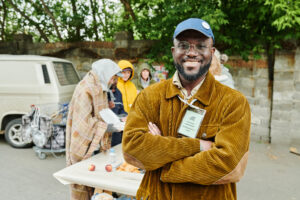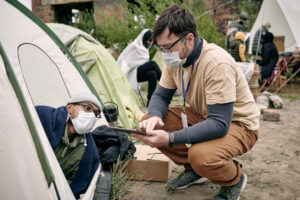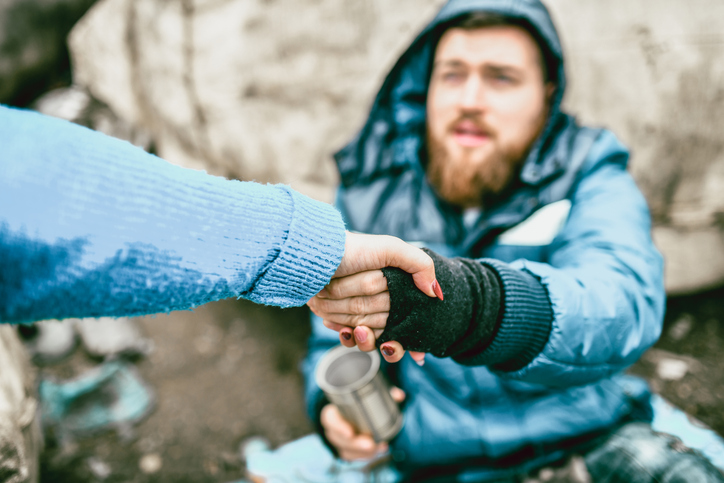Written by Helen Lewis
According to a recent report by the U.S. Department of Housing and Urban Development, more than half a million Americans were unhoused in 2022.
In the following article, we explore the unique characteristics of North Carolina’s housing crisis, as well as what social workers with and without clinical licenses are doing to help people experiencing homelessness. From advocacy to providing resources, MSWs are on the front lines of supporting people facing housing insecurity and homelessness.
Homelessness in North Carolina
In North Carolina, homelessness increased during the pandemic.
In 2020, 2,558 people were living without homes state-wide. By 2022, that number went up to 3,625. Sadly, children are also vulnerable to this statistical increase, with more families with children living on the streets than before the pandemic began.
This marks a discomfiting trajectory, as homelessness had statistically, and not insignificantly, decreased during the ten-year period preceding the pandemic: one report places incidents of homelessness as falling 24% between 2010 and 2019.
Surveying the post-pandemic data, experts remain uncertain as to whether these numbers are bound to go back down again. It remains to be seen whether the increase in homelessness in North Carolina is reflective of the unique circumstances of the pandemic, or if it is a sign of a longer-lasting, more urgent trend.
As you’ll see below, African-Americans are disproportionately represented in statistics of homelessness, and the same can be said of the demographics of unhoused people living in North Carolina. Though 22% of North Carolinians are Black, in 2019, 51% of homeless people in the state were African-American.
What Causes Homelessness?
Like many social issues, homelessness is a social issue with many possible causes, which can sometimes play off of and exacerbate one another.
Among these are factors such as:
- Unemployment, poverty, and low wages: Simply put, a lack of access to regular funds can quickly challenge an individual or family’s ability to keep up with mortgage or rent payments.
- Untreated mental illness: Though 6% of the American population has a diagnosed mental illness, 20-25% of homeless people in the United States are living with mental health conditions. Many of these people lack access to mental health care, often due to the cost of such treatment.
- Substance abuse: Substance abuse is considered to be both a cause and a byproduct of homelessness, with as many as two-thirds of unhoused people reporting a history of drug or alcohol dependency.
- Incarceration: Many rental and home ownership applications include a mandatory background check. This, in addition to extensive other legal barriers to re-entering civil society after incarceration, can dissuade renters, real estate agents, or sellers from signing a contract with an applicant with a criminal record.
- Escaping domestic abuse: Domestic abuse is the highest cause of homelessness among women, and teenagers who end up on the streets after running away from home often report having done so due to physical abuse.
- Lack of affordable housing: In 2014, Harvard University’s Joint Center for Housing Studies determined that America is experiencing a “crisis” in affordable rental living spaces. Two years earlier, statistics found that more than one-quarter of people in the United States are spending more than 50% of their earnings on rent.
- People temporarily unhoused as a result of a natural disaster: For this population, becoming re-homed is often easier, so long as the job and real estate markets remain stable.
Rising out of homelessness is a difficult task, one that often requires the support of people like MSWs. For one example, many job applications ask applicants to list their addresses. If an applicant is unable to list such an address, a prospective employer may look unfavorably at their application. This could be due to social stigmas around homelessness, which traps unhoused people in a cruel cycle of unemployment.
Similarly, a lack of access to transportation, a phone, basic hygiene, or the internet can impede peoples’ efforts to find work and improve their situations.
The Impact of the Pandemic
A recent analysis of U.S. Census data conducted during the pandemic found that Black, Hispanic, and Asian families were disproportionately likely to fall behind on mortgage and rent payments during the pandemic when compared to white families.
Higher rates of housing insecurity for households of color were partially a byproduct of racial disparities that preceded the pandemic, such as lower homeownership rates, incomes, and education levels. For example, 66 percent of white households … owned their homes, compared to 46 percent of Hispanic and 39 percent of Black households.
~ Researchers Sharon Cornelissen and Alexander Hermann
However, during the pandemic, Black and Hispanic families were disproportionately likelier than white families to suffer financial downturns due to the pandemic. The study found that there was a direct link between renters and homeowners falling behind on their payments and income loss or unemployment during 2020.
Though new policies were enacted during the first year of the pandemic to protect renters and homeowners, such as extended eviction protections, many families became housing insecure nonetheless.
Racial Inequality and Homelessness: The Importance of Cultural Competence in Social Work
Social workers are expected to have a sensitivity for cultural differences, one that is aware of the systemic inequalities that exist in the United States.
Issues of racial and socioeconomic inequality are closely intertwined in the incidence of homelessness. For example, though African-Americans make up 12% of the United States population, 37% of people living on the streets are African-American, and 50% of homeless families in the United States are African-American.
Similarly, women and children who might have left their homes due to domestic violence might also experience housing insecurity. According to the US Department of Housing and Development (or HUD), over 600 homeless people in 2019 both living in emergency shelters or living entirely without shelter were victims of domestic violence.
Domestic violence is consistently identified as a significant factor in homelessness … 92% of homeless women report having experienced severe physical or sexual violence at some point in their lives, and 50% of all homeless women report that domestic violence was the immediate cause of their homelessness. Domestic violence, homelessness, and housing insecurity are undeniably linked, as lack of safe and affordable housing is often reported as one of the primary barriers survivors of domestic violence face when they choose to leave an abusive partner.
As social workers, MSWs are expected to approach their clients through the related lenses of intersectionality and cultural competence. This means that MSWs develop an awareness of their own unique identities, their privileges, the power dynamic between social worker and client, and the possible intersections of marginalized identities that could make life more difficult for their clients.
The goal of cultural competence as it specifically relates to housing inequality and homelessness is to take a systemic, rather than a singular, approach to addressing an individual’s problems. By approaching clients with empathy and compassion, and allowing them to continue to feel dignity, social workers are likely to make the greatest impact on the changes they’d like to see take place.
What MSWs Are Doing To Help: Advocacy
 Master of Social Work (MSW) professionals in North Carolina have emerged as powerful advocates for the homeless community, leveraging their skills to bring about systemic change and address the root causes of homelessness.
Master of Social Work (MSW) professionals in North Carolina have emerged as powerful advocates for the homeless community, leveraging their skills to bring about systemic change and address the root causes of homelessness.
Their work often extends beyond the confines of traditional office settings. For one example, in 2011 and 2012, social workers in North Carolina focused their efforts on improving the lives of homeless students and their families enrolled at local public schools.
The social workers collaborated closely with students and their families, addressing bureaucratic barriers (like health records and birth certificates) and discussing the rights of families with children and their caregivers. Students in need also received donations of school supplies and clothing.
As counselors, social workers kept a careful eye on these students, making sure that they regularly attended school and didn’t fall behind in their courses. When necessary, social workers connected students to remedial tutoring. These social workers also made sure to notice when these underserved students became exceptional learners, and made sure that the students remained enrolled in school, and that they always had access to transportation.
Armed with resources, expertise, and a genuine commitment to fostering connections, these professionals worked tirelessly to understand the unique challenges faced by each individual student and family , tailoring their support to meet their immediate needs and fostering trust that formed the basis for longer-term solutions.
The school social workers also took their advocacy to the district and staff levels. Teachers and faculty participated in MSW-led workshops about unhoused students and families, with the goal of providing more sensitive accommodations for students with particularly high needs. As part of social workers’ efforts to maintain resources for unhoused students, such as food and transportation, they collaborated with staff and the school district to speak up for these students.
If a child were to switch schools, MSWs connected with the faculty of that institution, communicating background information about the student and their family that may be useful to reduce the difficulty of the transition. When appropriate, social workers familiar with a student’s family would provide connections to housing and other relevant resources.
More broadly speaking, the effectiveness of MSWs in outreach lies in their ability to create a compassionate and non-judgmental space for individuals experiencing homelessness. By meeting people where they are—physically and emotionally—MSWs build rapport and establish meaningful relationships. Through these connections, they gain insights into the underlying causes of homelessness, whether it be economic hardship, mental health struggles, or a combination of factors. This person-centered approach allows MSWs to develop targeted interventions that address the specific needs of each individual, promoting a sense of agency and empowerment in the face of adversity.
MSWs also collaborate closely with other outreach organizations, community leaders, and local businesses to create a network of support for the homeless population. By fostering partnerships, they ensure a more comprehensive and coordinated approach to outreach efforts. This collaborative model not only maximizes the impact of social work professionals but also promotes a community-wide understanding of the challenges faced by those experiencing homelessness, fostering a sense of collective responsibility and empathy that is essential for creating sustainable solutions.
What MSWs Are Doing To Help: Outreach
 The role of outreach workers is to meet individuals at their literal, judgmental, and metaphorical locations, fostering understanding from the client’s perspective. The essence of outreach for social workers lies in bringing services directly to neighborhoods, part of a larger spirit of accessibility for all that underpins this work.
The role of outreach workers is to meet individuals at their literal, judgmental, and metaphorical locations, fostering understanding from the client’s perspective. The essence of outreach for social workers lies in bringing services directly to neighborhoods, part of a larger spirit of accessibility for all that underpins this work.
Outreach is not just a transactional service; it treats the whole person by addressing medical, mental health, and life skills needs, emphasizing that individuals can become empowered and improve their circumstances themselves. Central to this process is the principle of respect for the client, ensuring person-centered services that instill hope for a better future and maintain a client’s dignity at all times.
An MSW’s ability to foster therapeutic relationships is paramount. This work requires time, effort, and patience to establish trust and effective communication. Meeting basic needs, such as securing food, clothing, shelter, and housing, forms a foundational component of outreach, contributing to the strength of the client-worker relationship.
Successful outreach relies on knowledgeable coalitions comprised of experts on diverse, recurrent issues like mental health, unemployment, and substance use. Ideally, MSWs will make these teams available during hours in which the traditional service system might not be accessible. MSWs will combine these services with community education programs, part of a larger effort to address community attitudes towards homelessness.
Flexibility and creativity are crucial for effective outreach, allowing clinicians to employ non-traditional approaches based on an understanding of clients’ daily activities. Encouraging client involvement in outreach enhances the success of an MSW’s mission, providing important lessons for the social workers and increasing a feeling of autonomy on the part of the client.
Of course, prioritizing safety, boundaries, and ethical considerations ensures the well-being of both outreach workers and clients. Ultimately, the end goal is to empower and integrate individuals who have experienced homelessness into greater stability through life skills education, job training, and fostering independence.
Supportive Services
For MSWs interested in becoming involved with social work to support the homeless, a comprehensive range of vital support services can help to address any of this population’s complex needs, such as:
- Shelters and Transitional Housing: Various shelters across North Carolina provide immediate refuge for individuals and families experiencing homelessness. Transitional housing programs offer longer-term solutions, assisting individuals as they enter more stable living conditions.
- Food Assistance Programs: Food banks, soup kitchens, and community meal programs ensure that those facing homelessness have consistent access to nutritious meals. This can also take place within an educational context, through free or reduced-cost school lunch programs.
- Medical and Healthcare Services: Clinics and health centers offer healthcare services tailored to the needs of the homeless population, addressing both physical and mental health concerns. Mobile health units may also reach individuals in more remote or underserved areas.
- Employment Assistance: Job training programs and employment services assist individuals in acquiring new skills, building resumes, and securing employment opportunities, aiming to break the cycle of homelessness through financial independence.
- Legal Aid and Advocacy: Legal services provide support for issues related to housing, eviction prevention, and accessing benefits. Advocacy organizations work to address systemic issues contributing to homelessness through policy change and community education.

- Counseling and Mental Health Support: Mental health professionals, including social workers and counselors, offer therapeutic services to address the emotional and psychological challenges faced by individuals experiencing homelessness.
- Educational Resources: Programs and initiatives provide educational support, including literacy programs and assistance with accessing educational resources, aiming to empower individuals to improve their circumstances.
- Substance Abuse Treatment: Rehabilitation and treatment services are available to address substance abuse issues, recognizing the intersectionality of addiction and homelessness.
- Transportation Assistance: Programs may offer support in accessing transportation, whether through public transit vouchers, assistance with obtaining driver's licenses, or other means to facilitate mobility.
- Hygiene and Clothing Support: Outreach initiatives often provide hygiene kits, clothing, and essential items to help individuals maintain personal hygiene and dignity.
- Child and Family Support Services: Programs specifically designed to support homeless families, including childcare services, family counseling, and assistance in navigating the education system for children.
- Veteran Services: Specialized services cater to homeless veterans, addressing their unique needs and challenges through programs that offer housing support, healthcare, and vocational rehabilitation.
- Financial Assistance Programs: Various organizations provide financial assistance to individuals and families facing homelessness, helping with rent payments, utility bills, and other essential expenses to prevent homelessness or facilitate rehousing efforts.







